Any idea of who could be replacing him after that, or would John Jacob Rhodes still end up becoming the next House Republican leader?This upcoming election in '80 could be a good point for him to retire imo... ending his career on a good note by steering the ship of the GOP one last time onto the new decade and all that
You are using an out of date browser. It may not display this or other websites correctly.
You should upgrade or use an alternative browser.
You should upgrade or use an alternative browser.
Blue Skies in Camelot (Continued): An Alternate 80s and Beyond
- Thread starter President_Lincoln
- Start date
good questionAny idea of who could be replacing him after that, or would John Jacob Rhodes still end up becoming the next House Republican leader?
Come to think of it, it might not be Rhodes given that he retired in 1981 in OTL. For the hell of it, I'm going to suggest random other Congressmen who could end up becoming House Republican Leader:good question
Arlan Stangeland from Minnesota
Bud Shuster from Pennsylvania
Ed Derwinski from Illinois
Thomas B. Evans Jr. from Delaware
Gene Snyder from Kentucky
Jack Kemp from New York
Joel Pritchard from Washington
Floyd Spence from South Carolina
Marjorie Holt from Maryland
Last edited:
Jack Kemp would be interestingCome to think of it, it might not be Rhodes given that he retired in 1981 in OTL. For the hell of it, I'm going to suggest random other Congressmen who could end up becoming House Republican Leader:
Arlan Stangeland from Illinois
Bud Shuster from Pennsylvania
Ed Derwinski from Illinois
Thomas B. Evans Jr. from Delaware
Gene Snyder from Kentucky
Jack Kemp from New York
Joel Pritchard from Washington
Floyd Spence from South Carolina
Marjorie Holt from Maryland
Bud Schuster would probably also be interesting just given that his real life career feels like he could have gone for the speakership if he wanted it.Jack Kemp would be interesting
TrueBud Schuster would probably also be interesting just given that his real life career feels like he could have gone for the speakership if he wanted it.
I might give my chapter a little editing, I like some of it but all I’ll say is that end part is kinda underwhelmin.
Chapter 128
Chapter 128 - Take the Long Way Home: More Foreign Affairs in the World of Blue Skies
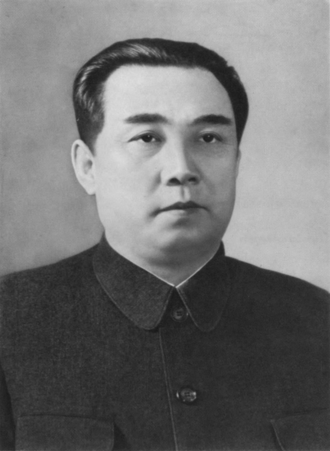
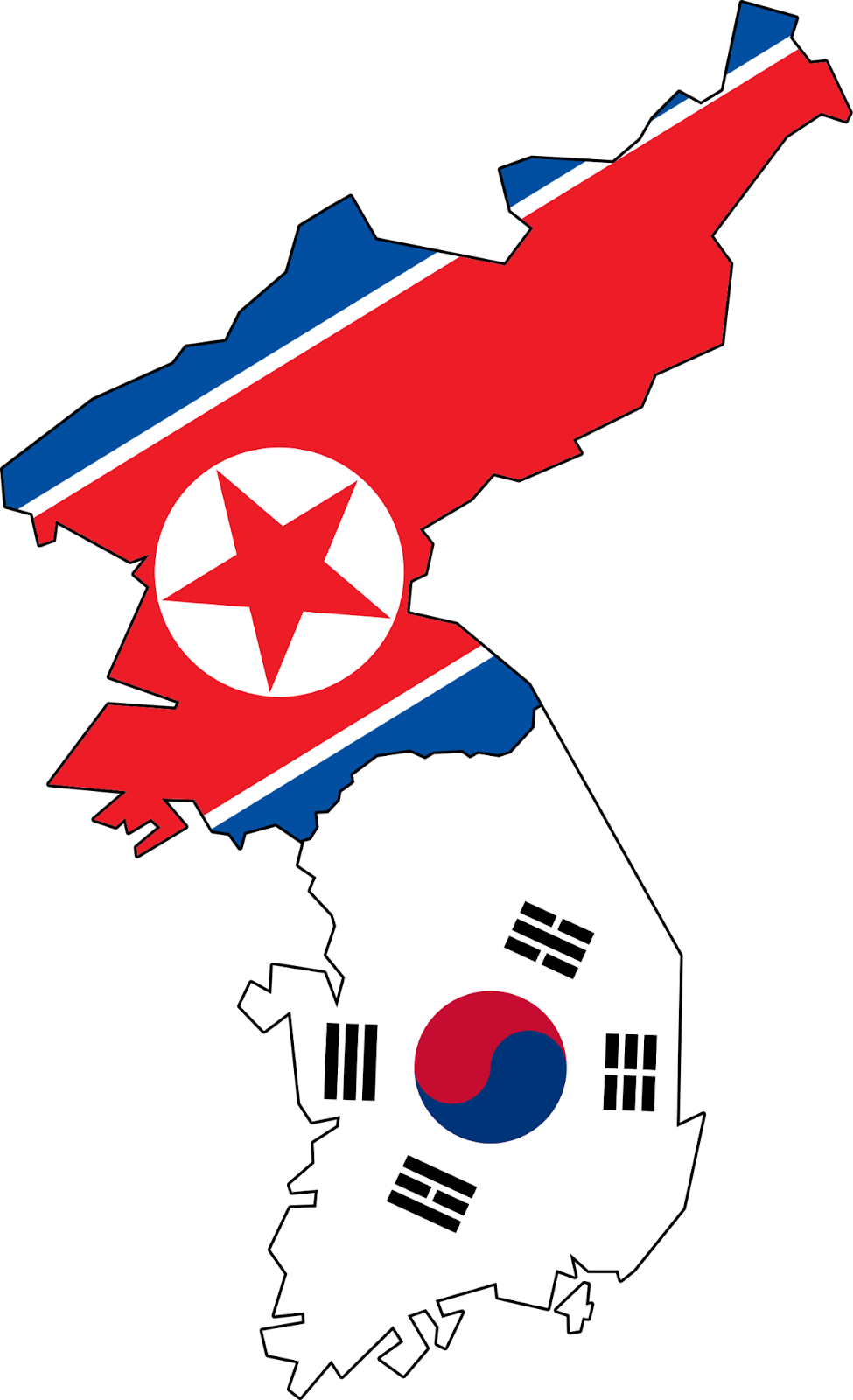
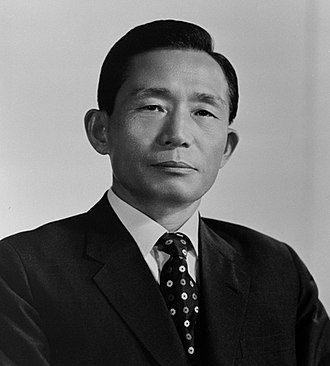
Above: Kim Il Sung, General Secretary of the Workers’ Party of Korea (left); Park Chung Hee, President and de facto dictator of South Korea from 1961 until 1979 (right).“When you're up on the stage, it's so unbelievable
Oh, unforgettable, how they adore you
But then your wife seems to think you're losing your sanity
Oh, calamity, is there no way out?
Does it feel that your life's become a catastrophe?
Oh, it has to be, for you to grow, boy
When you look through the years and see what you could have been
Oh, what you might have been
If you would have more time
So when the day comes to settle down
Who's to blame if you're not around?
You took the long way home” - “Take the Long Way Home” by Supertramp
“Peace secured by slavish submission is not peace.” - Kim Il Sung
“All of North Korea is a jail. We must be different. We must be better.” - Kim Young-sam, in a speech about the state of politics in South Korea
Since the end of the Korean War established the de facto reality of North and South Korea as separate political entities, one communist, the other capitalist, the two states spent the next several decades solidifying their hold on power.
With the end of the war, despite the failure to unify the peninsula under his rule, Kim Il Sung proclaimed the war a victory in the sense that he had remained in power in the north. However, the three-year war left North Korea devastated, and Kim immediately embarked on a large reconstruction effort. He launched a five-year national economic plan (akin to the Soviet Union's five-year plans) to establish a command economy, with all industry owned by the state and all agriculture collectivized. The economy was focused on heavy industry and arms production. By the 1960s, North Korea enjoyed a standard of living higher than the South, which was fraught with political instability and economic crises. Hoping to remain an independent communist leader in the world, Kim pioneered the development of the ideology that would come to be known as Juche. Highly nationalistic, his regime vowed that it would, “under no circumstances” allow itself to become a puppet or satellite state of either China or the Soviet Union. Achieving such a lofty aim for his country, however, would, in Kim’s mind, require harsh repression.
He created the songbun caste system, which divided North Korean society into three segments: core; wavering; and hostile. Citizens were placed into castes based on their political, social, and economic background. This system would decide all aspects of a person’s existence in society: access to education; housing; employment; food rationing; ability to join the ruling party; and even where a person was allowed to live. Alongside this, Kim also created a cult of personality around himself as the rightful, indispensable leader of the nation. He wanted his name to be held in equal or greater reverence to those of Marx, Lenin, Mao, and Stalin, and he instituted a system of strict punishments for those who disobeyed, or who questioned any aspect of his rule.
For the time being, however, Kim could largely get away with this. As previously stated, the standard of living in the north was much higher than that in the south throughout the 1960s.
Meanwhile, South Korea suffered immensely from a series of economic crises and political instability. Harsh, authoritarian rule was enacted as one “Republic” after another struggled and ultimately failed to establish itself and attain a sense of legitimacy. From 1961, when he gained power through a military coup, until 1979, when he was assassinated by Kim Jae-gyu, his close friend and director of the KCIA (South Korea’s equivalent of the CIA), Park Chung Hee, South Korea’s Third President, ruled as an authoritarian dictator, frequently amending the constitution as he saw fit to ensure his own grasp on power remained strong. His assassination, and the subsequent political crisis that followed, set the tone for what South Korea was to become: its rise, not as an authoritarian, western puppet regime, but as a beacon of liberal democracy in East Asia.
Immediately following the assassination of President Park on October 26th, 1979, then-Prime Minister Choi Kyu-hah, in accordance with the Yushin Constitution, became acting President of South Korea. Due to the unrest in his country that had resulted from his predecessor’s heavy-handed and much despised rule, Choi promised free, open elections. Under Park, “elections” always held wide public perception as being rigged, making genuinely contested elections one of the student protest movement’s top demands. Additionally, Choi promised a new constitution, one which limited the previously barely-checked powers of the president, and would create a more robust system of checks and balances. In the meantime, on December 7th, the National Conference for Unification convened and elected Choi to a term as president in his own right. He officially became the fourth President of South Korea.
But Choi’s grasp on power was tenuous at best.
Despite his promises to the protesters and liberals, Choi was largely seen by these groups as a toady for the late President Park. They trusted him about as far as they could throw him. Meanwhile, the military stood behind him and listened to Choi talk about opening the political sphere, about allowing free elections, and decreasing the power of the presidency. They balked.
In particular, Chun Doo-hwan, a major general in the South Korean army, who had been appointed to replace Kim Jae-gyu as head of the KCIA, believed that Choi was a spineless coward, ceding ground to the “rabble” in the streets. In Chun’s mind, reform was just a pretext for the beginnings of revolution. If South Korea was to eventually win the ideological “long war” with the north, they needed order, not the chaos of democracy. As head of “Hanahoe”, a secret military club which had enjoyed patronage under Park, Chun began to scheme about Choi’s removal from office basically from the moment he became acting president.
Three days after Choi’s election, on December 12th, Chun ordered the arrest of Army Chief of Staff Jeong Seung-hwa on charges of conspiring with Kim Jae-kyu to assassinate the President. This order was made without authorization from President Choi. On the night of Jeong's capture, 29th Regiment, 9th Division, along with the 1st and 3rd Airborne Brigades, invaded downtown Seoul to support the 30th and 33rd Security Group loyal to Chun, then a series of conflicts broke out in the capital. Jang Tae-wan, commander of the Capital Garrison Command, and Jeong Byeong Ju, commander of the special forces, were also arrested by the rebel troops. Major Kim Oh-rang, aide-de-camp of General Jeong Byeong-ju, was killed during the gunfight. By the next morning, the Ministry of Defense and Army HQ were both occupied. With them in hand, Chun was in firm control of the military. For all intents and purposes, he was now the de facto leader of the country. He then immediately set to work cementing his power, and laying the foundation for how he would legitimize his new rule. Protests flared up across the country once more. Riots broke out. The military squashed them forcefully, killing nearly 1,000 unarmed civilians. For all intents and purposes, it looked to the world like South Korea was about to have another of its military dictatorships.
This time, however, there was opposition.
…
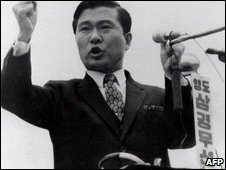
Kim Dae-jung was, among other things, a talented orator, a champion of democracy, and the unofficial leader of the South Korean opposition. For many years, he had been seen as “public enemy number one” by the Park regime. Kim Dae-jung had, after all, dared to run against Park in numerous presidential elections throughout the 1970s, questioning the legitimacy of the obviously bogus results, and publishing manifestos that not only challenged the government, but encouraged civil disobedience on the part of the citizenry. In 1973, Park had Kim kidnapped by the KCIA. He was put under house arrest and barred from politics. Then, in 1976, he was arrested and jailed for continuing to speak out against Park’s regime, though this was later commuted back to house arrest in 1978. This has led to Kim being labeled by some, “South Korea’s Nelson Mandela”. At about this same time, he was designated a prisoner of conscience by Amnesty International.
Though Kim had his political rights restored on December 10th, 1979 by recently elected President Choi, this decision was overturned shortly thereafter, following General Chun’s military coup. As popular protests erupted in Gwangju, Kim’s home province and political base, the developing Choi regime attempted to blame Kim. Rumors were started by the KCIA and swiftly spread. The government issued a warrant for his arrest. This time, however, Kim had been ready.
General John A. Wickam, US Armed Forces in Korea, had been made aware of the Chun regime’s intentions vis a vis Kim. They intended to arrest him, perform a show trial for the public, and swiftly execute him, to remove him as a possible political enemy. Wickam passed this information onto Stansfield Turner, Director of Central Intelligence back in Langley, Virginia, USA. Finally, the lead made its way to the Oval Office, where Turner reported on the situation to President Udall. The president was horrified. An ardent defender of democracy and human rights throughout the world, Udall would not stand for Chun’s scheme. He ordered Secretary of State George Ball to arrange for asylum for Kim, which was achieved swiftly, before Chun could truly cement his own power with a second coup, in May 1980. Despite Kim’s reluctance to leave his country, Udall, Turner, and Wickam managed to convince him that, for the time being, it was not only his best hope for survival, but also the best hope for eventually lighting the flame of democracy in South Korea. Kim eventually relented.
Under cover of darkness, he was picked up by a covert operations team and delivered to Osan Air Base. From there, he was flown overnight to Hawaii, setting down in Hawaii in the early hours of May 15th, 1980. Two days later, Chun orchestrated the predicted second coup. Upon discovering that Kim had fled the country, Chun was furious. Now “elected” South Korea’s fifth president in his own right, Chun phoned President Udall to demand Kim’s return to Seoul. Udall refused. For the rest of the year, the situation, and Kim’s status, remained in limbo. In Rome, Pope Stanislaus intervened on Kim’s behalf. He wrote to President Chun, asking that Kim be granted clemency, given his status as a Catholic. It also became a political issue on the campaign trail of the 1980 presidential election.
“What is your stance on Kim Dae-jung’s status? Should he continue to be granted asylum in the United States? And what should be done to repair America’s relationship with South Korea, one of our closest military allies?”
For the time being, the limbo persisted. And South Korea’s future, though bright, still seemed hidden behind towering storm clouds.
…


Above: Pope Stanislaus, during a visit to Paris, France in the spring of 1980
Above: Pope Stanislaus, during a visit to Paris, France in the spring of 1980
Born Karol Józef Wojtyła on May 18th, 1920, in Wadowice, Poland, the man would eventually become the Bishop of Rome in 1978, the first non-Italian pope since the 16th century, who had lived quite an eventful life to reach the pontificate.
In his youth, Wojtyła dabbled in stage acting, a skill which would later serve him well. In time, he would come to be known as one of the most well-spoken and eloquent popes in modern history. He also possessed a flair for presentation and body language, which made him appear always genuine and kind to those who saw him.
He graduated with excellent grades from an all-boys high school in Wadowice, Poland in 1938, shortly before the start of World War II. During the war, to avoid being kidnapped and sent off to a German slave labor camp, he signed up for work in harsh conditions in a quarry. Wojtyła eventually returned to acting, developing a love for the profession and participating at a local theater. Linguistically skilled as well, Wojtyła wanted to study Polish at university. Encouraged by a conversation with Adam Stefan Sapieha, he decided to study theology and become a priest, instead. Eventually, Wojtyła rose to the position of Archbishop of Kraków and then a cardinal, both positions held by his mentor.
Wojtyła, once elected, became at 58, one of the youngest popes in history. He immediately set out to improve the Catholic Church's relations with Judaism, Islam, and the Eastern Orthodox Church in the spirit of ecumenism, holding atheism as the greatest threat to the world’s Abrahamic religions. He maintained the Church's previous positions on such matters as abortion, artificial contraception, the ordination of women, and a celibate clergy, and although he supported the reforms of the Second Vatican Council, he was seen as generally conservative in their interpretation. Despite this, Pope Stanislaus also put emphasis on the centrality of family and identity, while questioning consumerism, hedonism and the pursuit of wealth. He criticized authoritarianism of all stripes throughout the world, and made it the official position of his pontificate to support democracy anywhere that it could. In time, Lech Wałęsa would describe Stanislaus, “giving courage to Poland to stand up for their freedom” against Soviet domination. Though in 1979, that remained very much a work in progress.
Next Time on Blue Skies in Camelot: Conflicts Around the World in the 1970s
Another awesome foreign relations update. Ugh, hate military strong-men.
Thank you both! Glad you enjoyed it.awesome chapter!
I'm also excited to announce an upcoming Guest Update is in the works!  @TrickyDick reached out to me with a great idea and has been workshopping it. Expect it in the near future.
@TrickyDick reached out to me with a great idea and has been workshopping it. Expect it in the near future.
If anyone else is ever interested in writing a post, or a part of a chapter, or even just making suggestions, feel free to drop them here or PM me as well.
If anyone else is ever interested in writing a post, or a part of a chapter, or even just making suggestions, feel free to drop them here or PM me as well.
Looking forward for people to see it!I'm also excited to announce an upcoming Guest Update is in the works!@TrickyDick reached out to me with a great idea and has been workshopping it. Expect it in the near future.
If anyone else is ever interested in writing a post, or a part of a chapter, or even just making suggestions, feel free to drop them here or PM me as well.
For anyone who’s been paying attention to what I’ve been saying for a while you may be able to deduce what the chapter is but I won’t spoil!
Great update seeing South Korea and North Korea. Looking forward to how different Poland will be going into the 1980s
Nice Korea update. Guess things are not going well in the South to say the least. However maybe things might work out better in the North if the economy does not stagnate…
Karol Wojtyła seems an interesting bloke, with his stances on consumerism and such, but possibly needs to loosen up on some of those other stances. It would be nice if he rooted out sex offenders of all types in the Church.
Karol Wojtyła seems an interesting bloke, with his stances on consumerism and such, but possibly needs to loosen up on some of those other stances. It would be nice if he rooted out sex offenders of all types in the Church.
It took me almost a week to finished this complete chapter on our country, but it was worth the time for me. I don't know if you're going to love it or not, but I did my best to fill those missing gaps that were not in this chapter. Mr. President, you'll be my guest!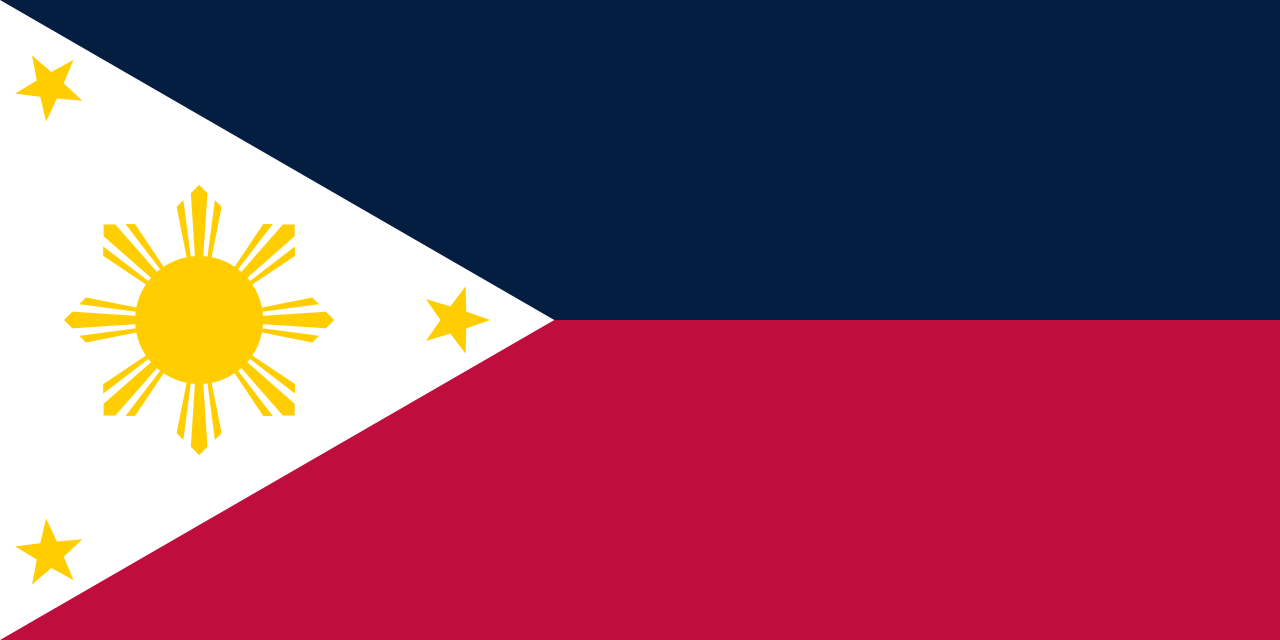
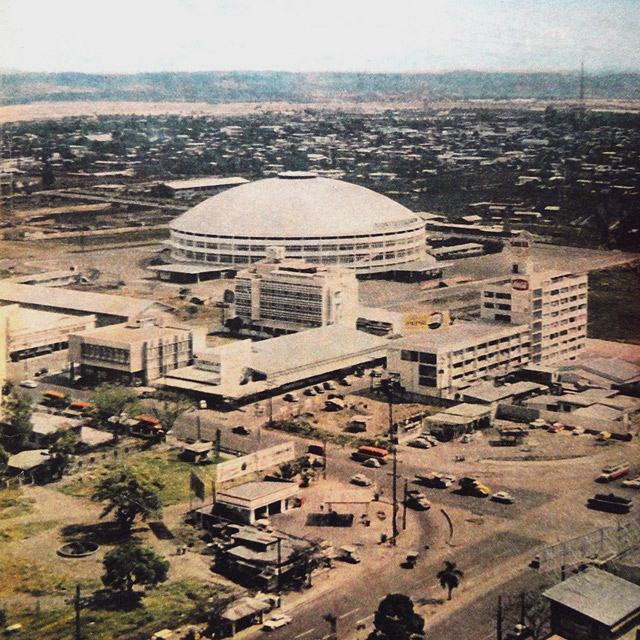
Above: Flag of the Philippines (left), and the Capital City of Quezon City looking at Cubao, one of the busiest districts with the now-famous Araneta Coliseum which was built in 1960. (right)
The Third Republic of the Philippines had undergone a tremendous transformation since achieving its true independence from the United States of America in 1946, following the end of Second World War. Though plagued at times by corruption and other domestic issues, as well as its uncertain place in the Cold War World, the nation had undergone modernization, change, and was beginning to find its place in the world throughout the 1960s and into the 1970s.
Especially transformative was the Presidency of Diosdado Macapagal.


Born on September 28, 1910, in Lubao, Pampanga, Macapagal was the third of five children in a poor family. His father was Urbano Macapagal y Romero (c. 1887 – 1946), a poet who wrote in the local Pampangan Language, and his mother was Romana Pangan Macapagal, daughter of Atanacio Miguel Pangan (a Former Cabeza de Barangay of Gutad, Floridablanca, Pampanga) and Lorenza Suing Antiveros. Urbano's Mother, Escolástica Romero Macapagal, was a midwife and schoolteacher who taught Catechism. Diosdado's family earned extra income by raising pigs and taking in boarders to their house. Due to his roots in poverty, Macapagal would later become affectionately known as the "Poor Boy from Lubao" to his supporters. Diosdado was also a reputed poet in the Spanish Language although his poetic work was eclipsed by his political career.
An excellent student, Macapagal graduated as Valedictorian from Lubao Elementary School, and Salutatorian at Pampanga High School. He finished his Pre-Law Course at the University of the Philippines, then enrolled at Philippine Law School in 1932, studying on a scholarship and supporting himself with a part-time job as an accountant. While in law school, he gained prominence as an orator and debater. However, he was forced to quit schooling after two years due to poor health and a lack of money. Returning to Pampanga, he joined his Boyhood Friend, Future Actor and Senator Rogelio de la Rosa in producing and starring in Tagalog Operettas. It was during this period that he married his friend's sister, Purita de la Rosa in 1938, and they had two children, Cielo and Arturo. She later died in 1943. After receiving his Bachelor of Laws Degree in 1936, he was admitted to the bar, topping the 1936 Bar Examination with a score of 89.95%. He later returned to his Alma Mater to take up graduate studies and earn a Master of Laws Degree in 1941, a Doctor of Civil Law Degree in 1947, and a PhD in Economics in 1957. His dissertation was entitled, “Imperatives of Economic Development in the Philippines”, and his work on it would shape his policies as President.
After passing the bar exam, Macapagal was invited to work at an American law firm, a unique honor for a Filipino Man at that time. He would later serve as Legal Assistant to President Manuel L. Quezon. During the Japanese Occupation of the Philippines in World War II, Macapagal continued working as an assistant now to President José P. Laurel, while secretly aiding the Anti-Japanese Resistance during the Allied Liberation Country from the Japanese. After the war, Macapagal worked as an Assistant Attorney with one of the largest law firms in the country, Ross, Lawrence, Selph and Carrascoso. With the establishment of the independent Third Republic of the Philippines in 1946, he rejoined government service when President Manuel Roxas appointed him to the Department of Foreign Affairs as the Head of its Legal Division. In 1948, President Elpidio Quirino appointed Macapagal as Chief Negotiator in the successful transfer of the Turtle Islands in the Sulu Sea from the United Kingdom to the Philippines. That same year, he was assigned as Second Secretary to the Philippine Embassy in Washington, D.C. In 1949, he was elevated to the position of Counselor on Legal Affairs and Treaties, at the time the fourth-highest post in the Philippine Foreign Office. It was also after the war that he met and married his second wife, Dr. Evangelina Macaraeg, with whom he had two children, Gloria and Diosdado, Jr.
He also began his career in politics. On the urging of local political leaders of Pampanga Province, President of the Philippines Elpidio Quirino recalled Macapagal from his position in Washington to run for a seat in the House of Representatives representing the 1st District of Pampanga. He won his race. For the next seven years, he served in that position, consistently being voted “The Most Outstanding Lawmaker” for his sharp mind and personal integrity. At the start of the 1950 Legislative Session, the Members of the House of Representatives elected Macapagal as chair of the Committee on Foreign Affairs, and was given several foreign assignments. He was a Philippine Delegate to the United Nations General Assembly multiple times, taking part in debates over Communist Aggression with Andrei Vishinsky and Jacob Malik of the Soviet Union. He also took part in negotiations for the U.S.-R.P. Mutual Defense Treaty, the Laurel–Langley Agreement, and the Japanese Peace Treaty. He authored The Foreign Service Act, which reorganized and strengthened the Philippine Foreign Service.
In May of 1957, the Liberal Party, a generally centrist to center-left party, drafted Macapagal to serve as their Vice Presidential Candidate, and the running mate of Jose Y. Yulo. While Yulo would go on to be defeated by the Nacionalista Candidate, Carlos P. Garcia, Macapagal was elected Vice President in an upset victory. As the first ever Philippine Vice President to be elected from a different party than the President, Macapagal served out his four-year Vice Presidential Term as a leader of the opposition. Simultaneously elected leader of the Liberal Party, Macapagal bided his time, and waited for his chance to make a real difference in office.
He got his chance four years later, when he defeated Garcia in his bid for re-election, winning the 1961 Presidential Election. His Vice Presidential Candidate Emmanuel Pelaez also won the election. Promising an end to corruption, and appealing to the electorate as a common man from humble beginnings, Macapagal set out at once upon taking office on an ambitious platform.


The New President began with a sweep of Economic Liberalization. Under his predecessors, the central government had instituted exchange and import controls. Macapagal did away with these and returned the economy to a Free-Enterprise System. Though further attempts at economic reform were blocked by the Nacionalistas, who controlled the Senate and House of Representatives at the time, President Macapagal was nonetheless able to achieve steady economic progress. Annual GDP Growth in the Philippines averaged at just under 6% from 1962-1965, roughly contiguous with Macapagal’s first term.
Macapagal’s end goal for adopting Liberalization was, first and foremost, to help the common man. Though he supported Free-Enterprise, Macapagal was by no means a Laissez-Faire Economist. He believed that the government had three jobs in developing the Philippine Economy: First, to provide infrastructure (what he called “social overhead”) such as roads, ports, airports, etc.; Second, to adopt fiscal and monetary policy that was supportive of domestic and foreign investment; and Third (and most important), to promote and support basic and key industries, particularly those that require too much startup capital for businessmen and capitalists to put up themselves. The key industries he chose to develop as the “Foundation” for the Philippine Modern Economy included: integrated steel manufacturing; fertilizers; wood pulp and paper; meat canning; and tourism. One of his successes during his first term in office was The Agricultural Land Reform Code, which provided for the purchase of private farmlands with the intention of distributing them in small lots to the landless tenants on easy term of payment. Another one was the creation of The Philippine Veterans' Bank, The Increased Minimum Wage Law, and The Moving of Philippine Independence Day from July 4th to June 12th, celebrating the day that the Philippines gained its independence from Spain in 1898. While July 4th was declared as Philippine Republic Day, making it also as one of the official holidays to this day.
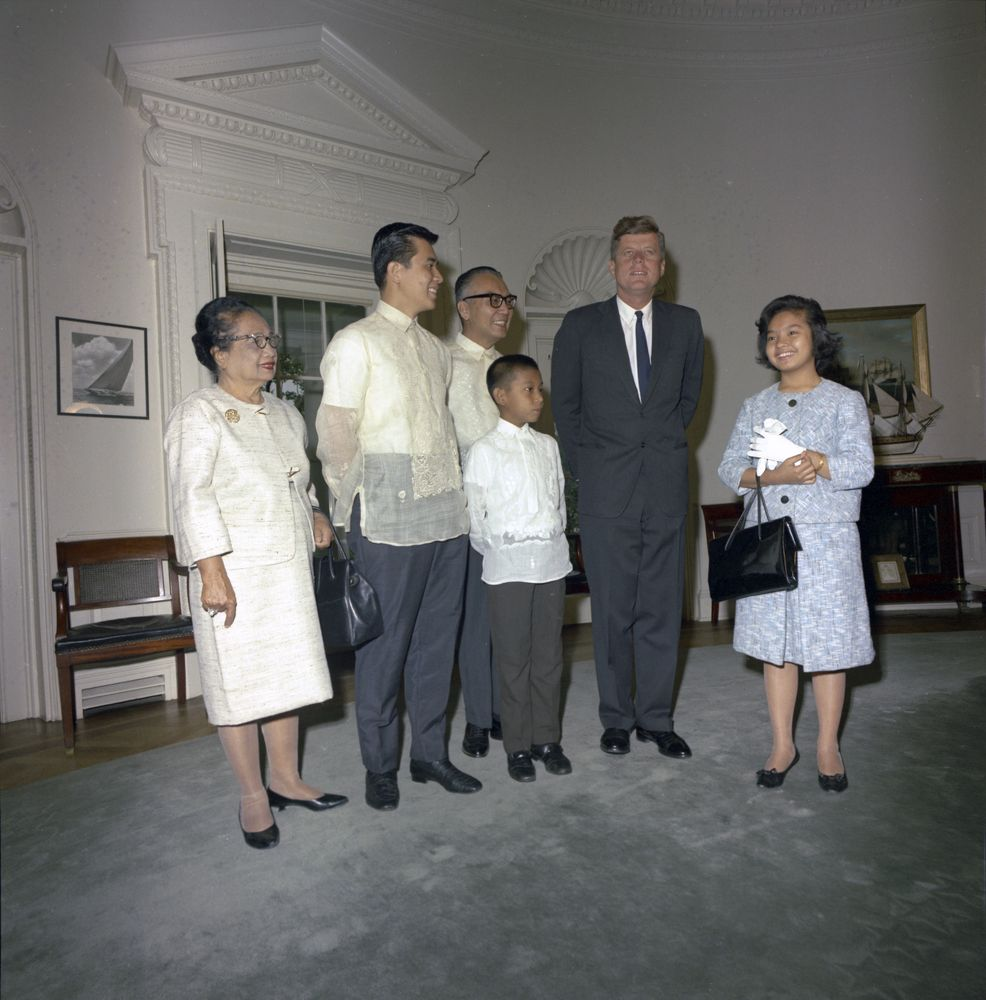 Above: A picture taken in the Oval Office of President Macapagal’s children and mother visiting American President John F. Kennedy in 1963. President Kennedy would return the favor in 1967, doing a week-visit to both former nation's capital Manila and its current nation's capital Quezon City on a trip abroad.
Above: A picture taken in the Oval Office of President Macapagal’s children and mother visiting American President John F. Kennedy in 1963. President Kennedy would return the favor in 1967, doing a week-visit to both former nation's capital Manila and its current nation's capital Quezon City on a trip abroad.
In Foreign Affairs, Macapagal forged a close alliance with the United States under President John F. Kennedy. Kennedy appreciated the kind of ethical, responsible governance that President Macapagal represented. He also wanted the Philippines to act as a bulwark of liberal democracy against Communist encroachment in Southeast Asia, and also declared that the country is now protected by The Kennedy Doctrine. Macapagal was happy to oblige this, encouraging American tourism and investments into his own nation. That said, he knew his nation also had other ambitions. When President Kennedy announced a full withdrawal of its troops in South Vietnam by passing The Gulf of Tonkin Resolution in August of 1964, Macapagal was surprised to hear the news because he's in favor of sending more troops to crushed North Vietnam. Kennedy called him and said that it's their war that can't be win, but we will provide them with every aid possible in defense of its shared values. He promised that Southeast Asia will not be abandoned as he did in Europe under his watch, and he will not let the South lose one either by trusting him on his plan. Macapagal later agreed on his decision and support him on his foreign policy. Macapagal addressed this news to the nation and the people agreed that give peace a chance, and later worked. His Vice President Emmanuel Pelaez and Secretary of Foreign Affairs Carlos P. Romulo, also continues its strong relations to the United States and its Allies as the country aligns with them during the Cold War. with He held on to claim Northeast Borneo, much to the consternation of the then recently formed Federation of Malaysia. Continued tensions throughout Southeast Asia would plague his presidency, and continued for years afterward.
His campaign against corruption was tested by Harry Stonehill, an American Expatriate with a $50-Million business empire in the Philippines. His Secretary of Justice, Jose W. Diokno investigated Stonehill on charges of tax evasion, smuggling, misdeclaration of imports, and corruption of public officials. Diokno's investigation revealed Stonehill's ties to corruption within the government. Macapagal, however, prevented Diokno from prosecuting Stonehill by deporting the American instead, then dismissing Diokno from the cabinet. Diokno questioned Macapagal's actions, saying, "How can the government now prosecute the corrupted when it has allowed the corrupter to go?" Diokno later switched his party to Nacionalista and served as a Senator. The administration also openly feuded with Filipino Businessmen Fernando Lopez and Eugenio Lopez, Sr., brothers who had controlling interests in several large businesses.

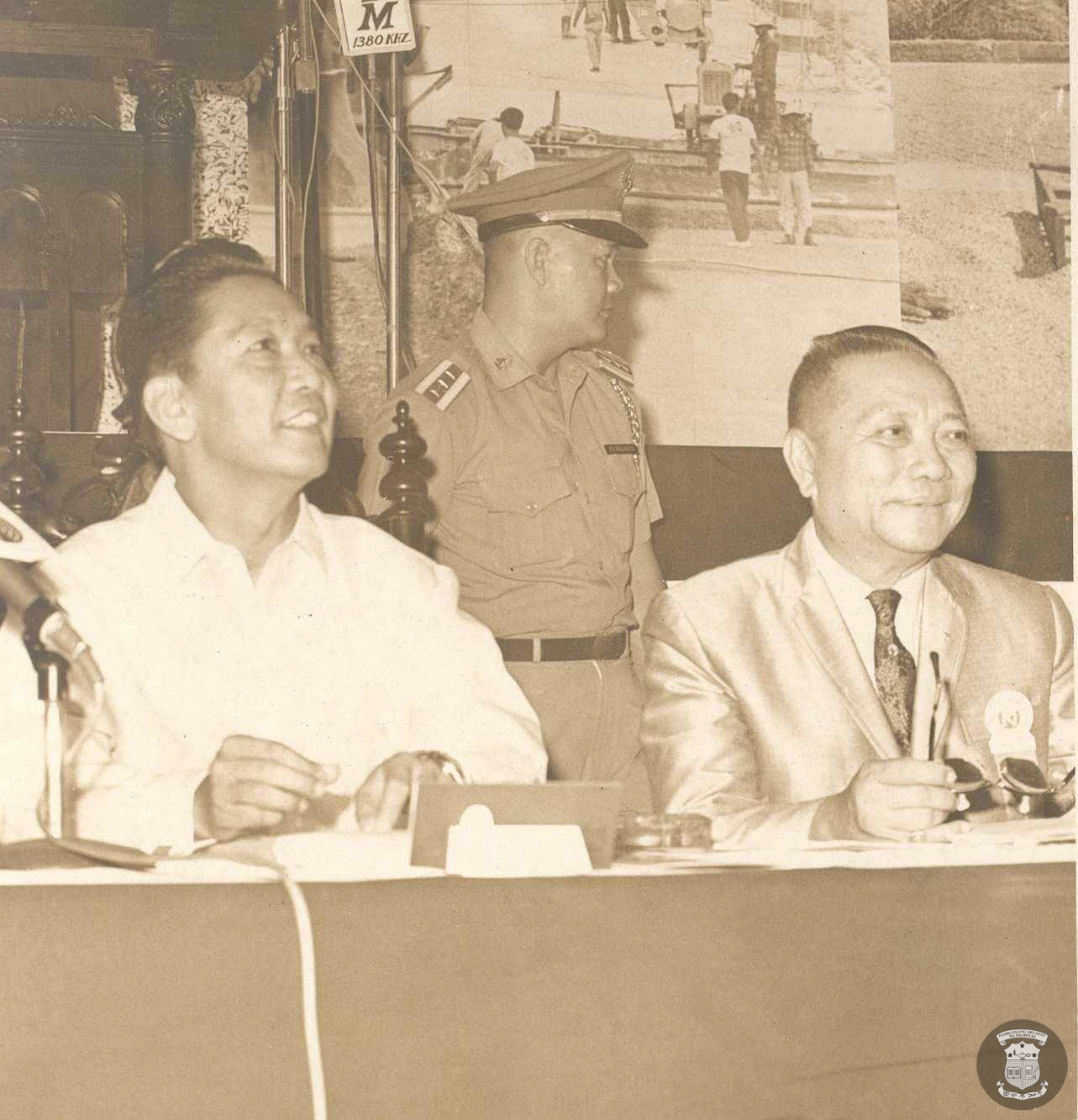
His Liberal Party gained 5 seats in the Senate during the 1963 Midterm Elections, thanks to the support of President Kennedy few weeks before his fateful day in Dallas despite the aftermath of The Stonehill Scandal. In 1964, Senate President Ferdinand Marcos, a fellow member of the Liberal Party, unable to win his party's nomination due to Macapagal's re-election bid, Marcos switched allegiance to the rival Nacionalista Party to oppose Macapagal for President, with Fernando Lopez as his Vice President. It was also during the election, Marcos's life became the basis of the Biographical Film Iginuhit ng Tadhana (Drawn by Fate). It was one of the earliest forms of media that they used as a political tool. Macapagal was shocked when the movie premiered during the election season, he immediately called JFK to ask the CIA to investigate and question his medals that he received during World War II. JFK published those documents on every local, national, and international press and stated that his claims to being the recipient of numerous military decorations, most of which were proven to be fraudulent. Marcos claimed he had spent much of the period between his August, 1942 release and his December, 1944 return to USAFIP as the leader of a guerrilla organization called Ang Mga Mahárlika ("The Freemen") in Northern Luzon. According to Marcos's claim, this force had a strength of 9,000 men. His account of events was later cast into doubt after a United States Military Investigation exposed many of his claims also as false or inaccurate. He also claimed to have been the recipient of 33 War Medals and Decorations, but found out that stories about the wartime exploits of Marcos were mostly political campaign propaganda, being inaccurate or untrue. The Gold Cross and the Distinguished Service Star – were only two that were given during the war. His supporters and the public were quickly got angry and disappointed on what they read on the papers. The people ate the story up and the press had a field day to which Marcos formally withdrawn from his candidacy few weeks before election day, ending his political career for good. His running mate for VP Lopez, all of Senatorial and Congressional Candidates, and its Nacionalista Party quickly distanced themselves and announced that they would disqualify him from the party immediately. The movie was now forgotten in Filipino consciousness just before the election. President Macapagal and Vice President Pelaez were re-elected again in the 1965 General Election in a major landslide victory, becoming the First Philippine President and Vice President to win a second term. The Liberal Party gained 5 seats in the Senate and 70 seats in the House of Representatives. Both houses were now dominant by his party and all of his policies and laws are now going to be easy to pass. Later in the 1967 Midterm Elections, Liberals gained 4 seats with the other 4 from Nacionalistas, and the Liberal Party continues to dominate its influence throughout the decade. Its ideology was similar to the Nacionalistas during Macapagal's first term. It wasn't during his second term that they begin to embrace towards to more liberal and progressive views that continues to this day.
Despite his re-election, Macapagal still had a myriad of issues to fight and he will pass those laws for the better future of his fellow Filipinos.
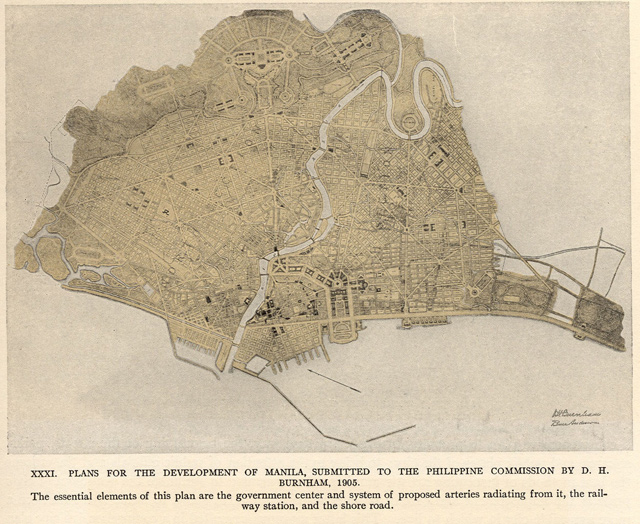

The Macapagal and its succeeding administrations would continue to develop the nation’s cities, following the outline of "The Master Plan of Manila” by American Architect Daniel Burnham. Paid from the complete reparations of the United States; passed the law from both houses of Congress through bipartisan support who unanimously agreed to revive the city to its former glory and prestige; and managed by the Department of Public Works and Highways with the help from all country's architects, engineers and laborers; the plan provided for infrastructure development to create a better transportation network of roads and waterways. Other public works by the Macapagal Administration (and its successors) included: creating numerous parks and recreational sites; building a New Government Center in Rizal Park (which was originally designed and proposed in the Early 20th Century); building new schools and universities from The Educational Modernization Act (including its transition to K-12); reviving and modernizing the Philippine National Railway System from its former stations in Antipolo, Batangas, Bicol, Cavite, Cagayan, Cordillera, and Lingayen; constructing and modernizing pier system in Manila Bay and throughout the country; the extension of Roxas Boulevard across from Manila Bay to Kawit, Cavite; and creating the National Capital Development Authority (NCDA) in 1973, an agency tasked with developing the National Capital Region (later named it officially in 1977).


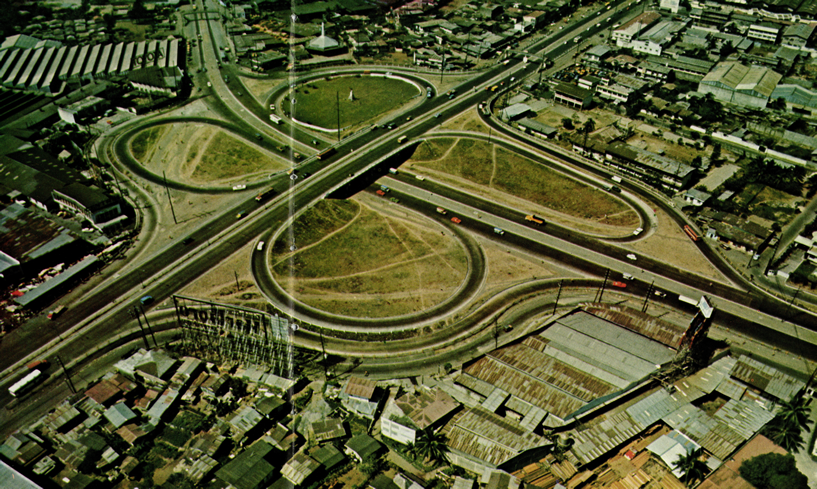
Many of the landmarks and famous buildings of the nation's cities which were destroyed during World War II were fully and completely rebuilt and restored during the 1970s and beyond to revive its tourism and national heritage; they're now protected by NCCA. Some examples of this included The Walled City Intramuros, The Rock Island of Corregidor, and The Oldest Shopping Center of Escolta. Due to its unique mix of Spanish and American Architectures, Manila during the American Period was known as “The Paris of Asia”, a title that The Government of Quezon City hoped to recapture. The City of Manila later got its place as one of the UNESCO World Heritage Sites in 1977, a title of which the people were now proud of. The beauty of all nation's cities became and would remain the highpoint of national pride. It was preserved throughout the 1970s and into the 80s via the revival and extension of The Manila Tram System (through joint partnership of the Lopez-owned MERALCO and The Philippine Government), the creation of The Greater Manila Subway System, the construction of the North Luzon Expressway (NLEX) and the South Luzon Expressway (SLEX). Together with infrastructure designed to accommodate and create The Mass Transportation Act - more trains, trams, busses, jeepneys, and taxis - traffic congestion was reduced, along with the country’s Carbon Footprint, as such things came to be known. Over time, cities like Manila City, Quezon City, Baguio, Cebu, Davao, and other highly-urbanized cities would both become popular tourist destinations the world over.
Perhaps the most significant legacy of Macapagal’s second term was that it represented a strengthening the bipartisan support from its both parties, exercising its liberal, democratic norms within the country, prevented the spread of Communism through containment, and saw continued, strong economic growth throughout the 1960s. Aside from that he created some of the impressive laws that benefitted a lot of his fellow Filipinos, including The Prison Reform and Rehabilitation Act, The Military and Constabulary Modernization Act, The Universal Health Care Act (now known as Philhealth), The Department of Environment and Natural Resources Act, The Board of Censors for Movies and Television Act, The Department of Housing and Urban Development Act, The Garbage Recycling Act, The Department of Energy Act, The Postal Service Modernization Act, The National Parks and Recreation Act, The National Historical Commission Act, The Philippine Olympic Committee Act, The Department of Education Act, and The Judicial Reform Act. President Macapagal came to Japan in paying the reparations that they damaged during the Second World War, the Japanese Government agreed to those terms. When President Kennedy arrived in the country, he promised all veterans who served in the US Army during World War II that they're going to get their pensions that they deserved and demanded after years of neglect after the war. It would finally be later signed by President Bush, who also served during the war that the veterans have finally got their military pensions. The Philippines saw the development of a strong democratic tradition over the next several decades, with the center-left Liberal Party and center-right Nacionalista Party holding successive governmental balance between them. This two-party system, operating under the 1935 Philippine Constitution that has been used since the Quezon Administration, remains largely unchanged and solid to the Present.
The 1960s brought a lot change and progress in the country. Fernando Amorsolo and The Thirteen Moderns were still leading Painters; Guillermo Tolentino was still the leading Sculptor; while Mars Ravelo, Francisco Coching, Pablo Gomez, and Larry Alcala were leading the Comics up until before the turn of the millennium; Pitoy Moreno is gaining international recognition in Fashion; the Third Generation-Filipino Architects were still leading the Modernism Architecture; directors like Lamberto Avellana, Gerardo de Leon, and Eddie Romero were at the top of Movies; Daisy Avellana and Wilfredo Maria Guerrero are doing Theatre; Diomedes Maturan, Ruben Tagalog, Pilita Corrales, Levi Celerio, and Sylvia La Torre were making Music; and author Nick Joaquin is writing his Literature on the country's history and culture. It was during this decade when Philippine Television was on its Golden Age with ABS-CBN Ch. 2 & 4 leading as the country's largest network since its birth in 1953, were merged after they owned by the Lopezes in 1967. Entertainment shows like Tawag ng Tanghalan, Buhay Artista, Nida-Nestor Show, Student Canteen, and Kuwarta o Kahon were some of the famous and memorable. While newscasts like The World Tonight, Newsbreak, Balita Ngayon, & Apat na Sulok ng Daigdig were now become staple and the longest-running news in the country. ABS-CBN was one of the first in Color Television, moved their new studios in South Avenue, Quezon City; and gave some of the impressive live coverage like The Beatles' Concert in Manila, President Kennedy's visit to Manila, 1968 Summer Olympics in Mexico City, 1968 US Presidential Elections, and The Apollo-Svarog XII Moon Landing. ABC Ch. 5 were opened by Chino Roces of The Manila Times in 1960, RBS Ch. 7 opened by Robert Stewart in 1961, RPN Ch. 9 opened by Roberto Benedicto in 1969, PBS Ch. 10 was opened by the Philippine Government in 1965, MBC Ch. 11 was opened by the Elizalde Family of DZRH (the oldest radio station in the country since 1939) in 1962, and IBC Ch. 13 opened in 1959 by Andres Soriano, Sr. (later by Andres Soriano, Jr.) of The San Miguel Corporation. The country was known as one of "the freest press in Asia", and was still at "The Golden Age of Philippine Journalism"; enjoying and exercising its press freedom. Some of the famous newspapers in the country are The Manila Bulletin, The Manila Chronicle, The Tribune, Taliba, The Manila Times, BusinessWorld, Philippine Free Press, The Herald, Evening News, and Weekly Graphic. It was also during this decade when Rufino Santos was become the first Filipino Cardinal by Pope John XXIII in 1960, he remains to be the cardinal until his death in 1973. Also during the decade was the death Felix Manalo in 1963, the founder and leader of Iglesia ni Kristo was succeeded by his son Erano Manalo who later expanded its religion throughout the world by the late 1960s. MERALCO was now owned by the Lopezes in 1962, continuing its electric service across the country and planning the company of underground electric wiring while putting light posts above the ground. Their new offices was moved to Pasig City, with the head office was built by Jose Maria Zaragoza in 1968. PLDT meanwhile was now transferred to the Cojuanco Family, also joined with MERALCO on underground telephone wiring and continuing its excellence in telecommunications. Their head office was also moved to Mandaluyong City with the new building was built by Leandro Locsin in 1968. San Miguel Corporation was now lead by Andres Soriano, Jr. and he was credited with instituting modern management, including decentralization along product lines. The company still owned Royal Tru-Orange, Magnolia, and bottling and distribution of Coca-Cola in the country. The Ayalas established the Ayala Corporation in 1968, the same year that they acquired The Bank of the Philippine Islands or BPI and expanded Ayala Land that would be famous for its real estate and shopping business. The Makati Business Center was emerging form its shell and becoming the successor of Escolta as the leading shopping and business district. While Henry Sy and his ShoeMart (simply called SM), was starting to expand its business by not just selling shoes, but also becoming a major shopping mall in the future.


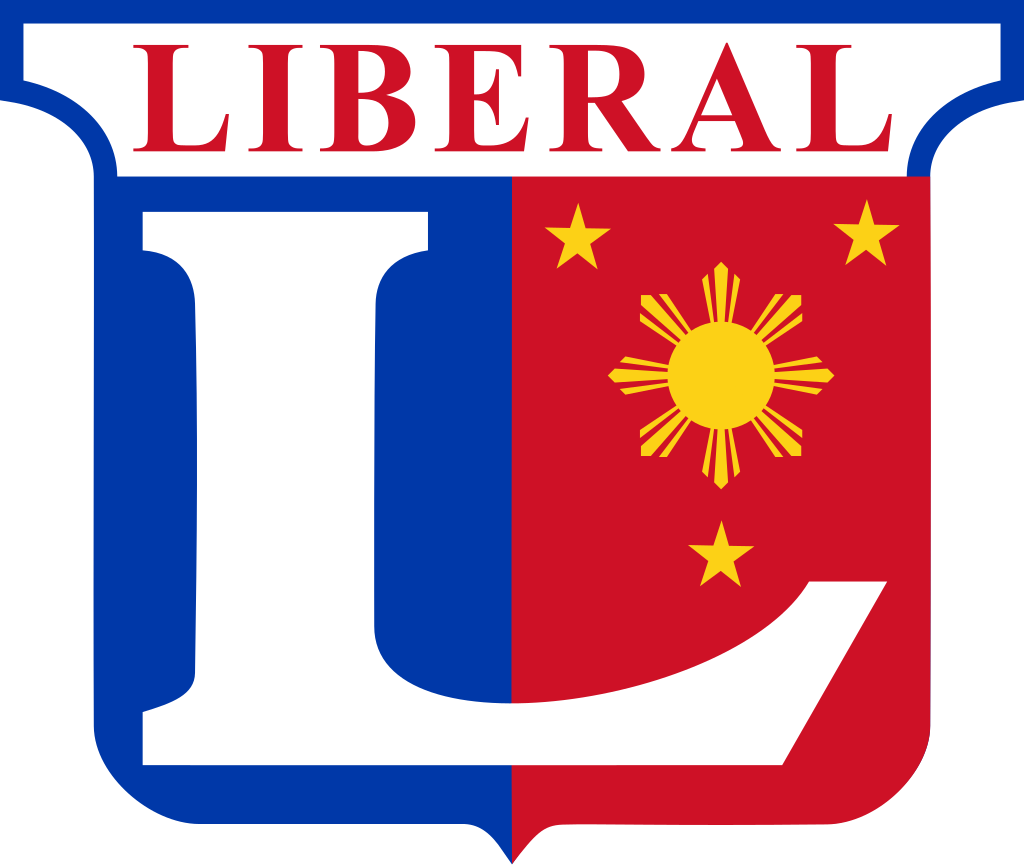
Above: President Diosdado Macapagal (LP) after he announced his successor, Senator Jovito Salonga (LP) at the Liberal National Convention. (left) President Jovito Salonga (LP) and Vice President Lorenzo Tañada (LP) from 1969-1977. (middle) The new logo of the Liberal Party form 1969-Present. (right)
With the two-term limit by the 1935 Constitution and finally fulfilled his duties as their leader, President Macapagal quietly retired from public life, supporting his chosen successor, Senator Jovito Salonga for President and Senator Lorenzo Tañada for Vice President in the 1969 General Election. Senator Salonga was reluctant first to accept the position a year ago because it was President Kennedy who convinced him when he was invited in Washington for a meeting. He has doubts at first because he'll be the First Philippine President of Protestant Faith in a Predominantly-Catholic Nation if he's elected. Kennedy understands that because he's been there before and battled through way out until he won the election in 1960. Salonga finally accepted the offer and he officially run against the Nacionalista Party's Gil Puyat and Arturo Tolentino for President and Vice President respectively. ABS-CBN did its first Philippine Presidential, Vice Presidential, and Senatorial Debates, added to another milestone in the network was also doing all the live coverages of the 1969 Election. ABS-CBN proves to their viewers that television can be as major as radios and newspapers, setting the bar for other major networks to follow years later. Salonga and Tañada would win that election and go on to continue and expand Macapagal’s reforms and policies. His inauguration was got a live coverage from the ABS-CBN, another first in history. President Romney congratulate him after he was elected and he hoped that they worked together, President-Elect Salonga also agreed and continue its relations between the two countries. Romney sent Vice President Bush to attend Salonga's Inauguration and praised him for "his adherence to democratic principles and to the democratic process." While the Liberals gaining 6 seats in the Senate, the Nacionalistas gained 90 seats in the House of Representatives. Despite the opponent's control in Congress, Salonga would like to continue its bipartisanship that his predecessor did. In his inaugural address, President Salonga wishes to continue bipartisanship in the now-divided Congress, and he added that "We must set politics aside and do the right thing like President Kennedy did during his time in office". The nation were all agreed with his address and Kennedy became an inspiration to the world, that set the standard and continues to this day in the country. President Salonga would become an advocate for social welfare and environmental stewardship, he'll implements policies to protect natural resources and improve social services. Vice President Tañada advocates for human rights and legal reforms. Their administration would see advancements in civil rights, civil liberties, education, and promoting equality.
As the country enters the new decade, uncertainty welcomed by a lot of them. Cambodian War was starting to escalate, student demonstrations were becoming a norm, and the country was in question of whether its armed forces should be involved with the United States in the conflict to protect the flame of liberty abroad. President Salonga ordered its armed forces to send in Cambodia not to fight with the Americans, but to aid those troops and its people with humanitarian causes. Salonga didn't criticized the protesters, but praised to hear their opinions and sided with them in solidarity and for awakening its national causes. Students, laborers, and peasants were lukewarm with his statement but later thanked the president for letting them exercise their freedom of speech. With the dawn of patriotism and nationalism in the country, he ordered that all government institutions must changed its name to national language. He ordered that Tagalog should be the official national language, in memory of Former President Quezon who later go the nickname "The Father of the National Language". With the flourishing arts and letters, and sciences, he created The National Commission for Culture and the Arts, The Order of the National Artists for giving their contribution and its history in the name of arts. While The Order of the National Scientists was for giving their contribution and its history in the name of science. In keeping the country's arts and culture, he created The National Museum of the Philippines Act to display all of the arts and letters to The Legislative Building by 1973. With the completion of The Burnham's Plan of Manila on the same year, both houses of Congress were moved to the New Capitol Building in Rizal Park at the beginning of The 8th Congress of the Philippines in 1974. Agriculture in the country was at its peak, thanks to The Agriculture Reform Law, farmers and fishermen were continuing its productivity and avoided Communism as their alternative for uprising. With more children and youth going to schools and universities, he created The Full Scholarship Act and The Magna Carta for Education Act to the point that education increased and continued to this day. In keeping the country form its corrupt practices, he created The Code of Conduct and Ethical Standards for Public Officials and Employees Act, Anti-Coup d'état Act, and The Anti-Plunder Act, making the country's excellence in public service. With the party's continuation of its liberal and progressive views, both President Salonga and Vice President Tañada welcomed the country for birth-control pills, divorce, abortion, and LGBT+ Rights. While the Filipinos celebrated, the Catholic Church were disappointed on allowing with this new views. Even they were unofficially declared persona non grata by the church, the people enjoyed it and even The Supreme Court sided with them of being protected by The Bill of Rights of The 1935 Constitution. With Former President Kennedy once opened its doors again to lead in the talks of China after the removal of Lin Biao to be replaced by Zhou Enlai as the new leader, Kennedy insisted to Salonga to keep its American Bases in Subic, Zambales and Clark, Pampanga in case of China invaded the Kalayaan Group of Islands if all of those bases removed. Both President Salonga and Vice President Tañada were already planning on removing those bases in continuing their stance on nationalism to end its American influence. After its reconsideration, they reluctantly agreed to those terms in letting Filipinos to be accepted employment in the bases, and both US and Philippine Navy to cooperate in guarding South China Sea which was later signed by President Bush. President Salonga would later visit Beijing and continue to strengthen their relations with the help of Senator Salvador Laurel (NP), who was in favor to have open dialogue and make an agreement with the Chinese Government to avoid their invasion of the Kalayaan Group of Islands and other nearby territories that are protected of Philippine Area of Responsibility (PAR) and Exclusive Economic Zone (EEZ) of which the Chinese agreed to. The Liberals gained 7 seats in the Senate, with only 1 seat from the Nacionalista in the 1971 Midterm Elections. Salonga and Tañada were re-elected again in the 1973 General Elections unopposed, the first in the election history. The Liberals gained only 3 seats in the Senate, the rest of 5 goes to the Nacionalistas who still got the majority control in the House of Representatives. Later in the 1975 Midterm Elections, the Liberals gained 4 seats with the other 4 for the Nacionalistas. While the world suffered form The Oil Embargo and its Recession, the country's economy weren't affected in favor of removing the use of oil with the exemption from the government's mass transportation plan in favor of clean energy and eliminating its carbon footprint. Economy during his time continues to improve with low crimes, improved income per capita, increasing literacy and employment rates. Salonga created The Disaster Risk-Reduction and Management Act, to immediately act on every emergency response and create more projects to prevent disasters from ever happened again. In continuing its press freedom, he created Kapisanan ng mga Broadkaster ng Pilipinas (KBP) to set some ethical standards in journalism. He also organized the regions of the country with The Philippine Region Reorganization Act, The Local Government Act was became the blueprint on fixing their local government units, protected the rights of all indigenous tribes with The Indigenous Filipinos Protection Act, and also the rights of all Muslim Filipinos in Mindanao with The National Commission of Muslim Filipinos. He also reorganized The Philippine Constabulary and The Integrated National Police, to be The Philippine National Police (PNP) in 1975. President Salonga even ordered the new PNP to let the demonstrators and protesters to exercise their freedom of expression, speech, and assembly that is written in the 1935 Constitution. With his second term ended in 1977, President Salonga retired from the public to support his Vice President Tañada for President and Senator Francisco Rodrigo for Vice President. The Nacionalistas got Senators Jose W. Diokno and Salvador Laurel for President and Vice President respectively.
The 1970s gave birth to the Original Pilipino Music (OPM) with some of the industry's finest like Juan Dela Cruz Band, Apo Hiking Society, Rico J. Puno, Sampaguita, Cinderella, Freddie Aguilar, Celeste Legaspi, Eddie Peregrina, Victor Wood, Asin, and Dakila. Their music would dominate the airwaves of radio and would gained international recognition for years to come; Benedicto Cabrera meanwhile would dominate the industry who would later lead the Philippine Contemporary Art for the rest of the decade; Napoleon Abueva was making waves as one of the famous sculptors of his time; Lino Brocka and Ishmael Bernal gained a lot of international recognition for their directorial masterpieces, tackling socio-economic-political issues, and brought the decade of movies to a new direction; Leandro Locsin is giving the architecture that combined Filipino and Brutalist elements; I.P. Santos gave the landscape architecture on some of the famous landmarks a unique look by combining nature and contemporary designs; And Rolando Tinio, Salvador Bernal, and Tony Mabesa were giving their craft in theater. Television was also changing during this decade. ABS-CBN finally reached nationwide after building their networks across the country, which later created the ABS-CBN Regional Network Group in 1973. It was also in ABS-CBN that debut on one of the longest-running sitcom of all-time: John en Marsha. Created by Ading Fernando, and starring Dolphy and Nida Blanca. The show premiered from 1971-1991. ABC also followed too on reaching their network nationwide. RBS was in a change of command when its founder Robert Stewart step down from the network while the country is promoting Filipino Nationalism. He passed it to the Triumvirates: Felipe Gozon, Jr., Gilberto Duavit, and Menandro Jimenez; they renamed the network as GMA Radio-Television Arts in 1974. GMA gave birth to one of their first newscasts: News at Seven, with Tina Monzon-Palma leads the news of the nation. Sports in the country forever changed with the creation of the Philippine Basketball Association (PBA) in 1975, a counterpart to the NBA in the United States. Basketball in the country was their national pastime and become a part of the culture. ABS-CBN even got its live coverage of the First Season of the PBA, which they also got the airtime rights to this day. They also got the live coverage of The Thrilla in Manila, a boxing match between Muhammed Ali and Joe Frazier that happened in the Araneta Coliseum on 1975. President Salonga created The Philippine Athletes Pension Act, in giving every benefits to every athletes and their families who gave their lives and their pride in the name of sports. With the death of Cardinal Santos in 1973, he was about to replace by one of the most influential Filipino Cardinals in history: Cardinal Jaime Sin. His views on abortion, contraception, and same-sex marriage are still against them as the world starting to embrace those progressive views and the Catholic-Majority nation was only time tell who dares to creates and passed those laws in the future. With The Second Sexual Revolution spreading around the world, protesters who are in favor of the progressive and liberal views were starting to take its shape. Cecilia Munoz-Palma making wave in history as the first female Associate Justice of The Supreme Court in 1973, inspiring women in law for years to come an became an icon in feminism history.


Above: President Jose W. Diokno (NP) and Vice President Salvador Laurel (NP) since 1977. (left) The logo of the Nacionalista Party since 1953 (right)
It was said by the critics that Senators Diokno and Laurel, gave some of the most memorable, inspiring, and wittiest remarks that truly won the hearts of Filipinos both in the 1977 Presidential and Vice Presidential Debates. Tañada and Rodrigo were outmatched by their oratory skills to the point that they admit their defeat in one of those debates. Diokno and Laurel won the 1977 General Elections, the Nacionalistas got the most seats in the House of Representatives, the Senate only got 2 seats with the other 6 goes to the Liberals. With the divided Congress, President Diokno and Vice President Laurel continue some of President Salonga's reforms and policies. With the economy doing one of the best as the world starts to recover, the country was enjoying the performance in the world stage. President Diokno continues his advocacy during his campaign on human rights, social justices, good governance, and transparency. While Vice President Laurel worked his way to improved the economy, promotes peace and stability in the country, and flexing international diplomatic relationship with other countries, which was doing good and maintains to this day. As the day he assumes the oath of office, President Diokno strengthens the Judiciary by giving The Supreme Court its judicial independence. President Udall even admired him for doing the hardest job that he managed to solved. He passed some laws like The Investment Incentives Act, The Export Incentives Act, The Revised Election Law, The National Telecommunications Commission Act, The Economic Development and Social Progress Act, and The Universal Basic Income Act. Continuing its clean energy that his predecessor did, he put some funds for alternative energy like solar, wind, and hydroelectric power. While the world continues to build nuclear power plants, he's one of them who opposed to build one after on what almost happen in Three Mile Island. President Udall even called him to try to convinced him on building one to end the country's dependence on fossil fuels and coal. President Diokno was lukewarm at first, he finally agreed to create some funds on building one to make electricity cheaper and can produced more to the community. In the 1979 Midterm Elections, Nacionalistas got only 3 seats in the Senate with the other 5 to the Liberals again. President Diokno and Vice President Laurel were re-elected again in 1981 against Senators Rogelio de la Rosa and Ambrosio Padilla of the Liberal Party.
As of today, the economy would go on to become one of the strongest in Asia, adding service-based industries like education, healthcare, agriculture, and tourism. This economy became the engine that powered a robust social safety net for the country, as well as a truly free, truly protected press, and a flourishing scene for sciences, arts, letters, and culture. The Manila International Film Festival, which was founded in 1980, would become a point of national pride for the Philippines alongside its architecture, literature, visual arts, music, theater, movies, television, and fashion. As the decade brought to the close, Manila Sound was becoming a new hit in the radio airwaves with musicians and singers like VST & Company, The Boyfriends, Sharon Cuneta, Eva Eugenio, Hajji Alejandro, Rey Valera, Marco Sison, Lani Misalucha, Hotdog, and Ryan Cayabyab. As the end of the noontime show Twelve o' Clock High, starring Ariel Ureta and Tina Revilla, it was replaced by now the longest-running noontime show in television history: Eat Bulaga! Debut on July 30, 1979 in ABS-CBN with hosts Tito Sotto, Vic Sotto, and Joey de Leon (also called as TVJ), it changed the way of noontime show and television forever. The comedy trio also did one of their famous sitcoms: Iskul Bukol. The show premeired the year before from 1978-1988. Also in 1979, when Noli de Castro and Mel Tiangco replaced Ric Tierro as the new newscasts of Balita Ngayon on ABS-CBN-2 and Maria Montelibano replaced Duds Rivera and Ernie Garcia as the new newscaster of Newsbreak on ABS-CBN-4. Directors Celso Ad. Castillo, Mike de Leon, and Mario O'Hara were joined by Brocka and Bernal in making some of the iconic movies of all-time and welcoming the new decade, embracing the future of filmmaking. Kidlat Tahimik, also gained international recognition by making experimental cinema. Making him ahead of his time in film history. It was during 1978, that Jollibee came into existence. Founded an created by Tony Tan Caktiong, the fast food chain would lead the country and be part of its culture, and soon would build more chains from around the world.
Last edited:
I have written some notes on Marvel's first superheroe film in TTL after seeing the success of the DC films and wanting to copy that success, who the actors could be. Want to hear them ?I'm also excited to announce an upcoming Guest Update is in the works!@TrickyDick reached out to me with a great idea and has been workshopping it. Expect it in the near future.
If anyone else is ever interested in writing a post, or a part of a chapter, or even just making suggestions, feel free to drop them here or PM me as well.
It will be interesting to see how the Butterfly effects of different popes and early Me too So have I movements effect the Church's handling of Priests who are found to have unnatural urgesNice Korea update. Guess things are not going well in the South to say the least. However maybe things might work out better in the North if the economy does not stagnate…
Karol Wojtyła seems an interesting bloke, with his stances on consumerism and such, but possibly needs to loosen up on some of those other stances. It would be nice if he rooted out sex offenders of all types in the Church.
Share: